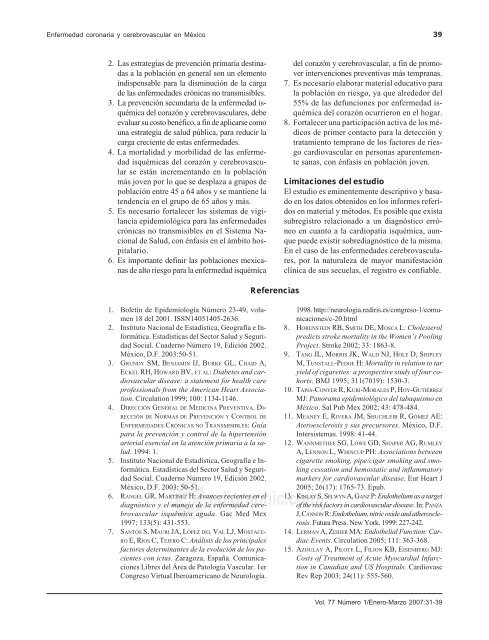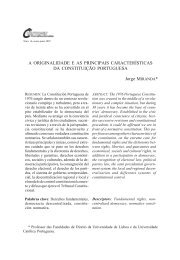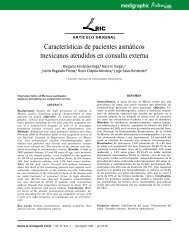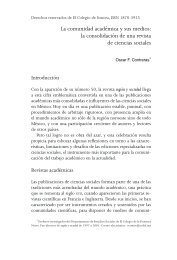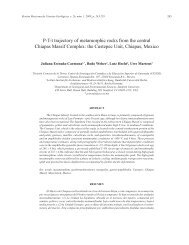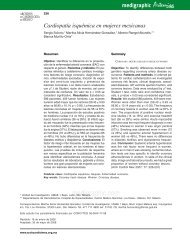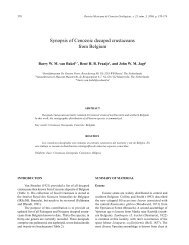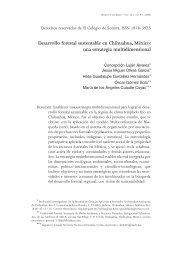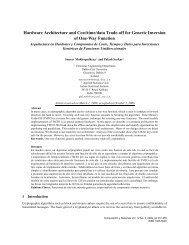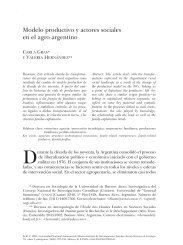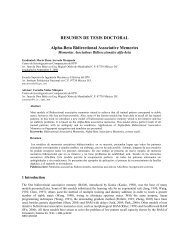Morbilidad y mortalidad de la enfermedad isquémica del ... - SciELO
Morbilidad y mortalidad de la enfermedad isquémica del ... - SciELO
Morbilidad y mortalidad de la enfermedad isquémica del ... - SciELO
You also want an ePaper? Increase the reach of your titles
YUMPU automatically turns print PDFs into web optimized ePapers that Google loves.
Enfermedad coronaria y cerebrovascu<strong>la</strong>r en México 39<br />
2. Las estrategias <strong>de</strong> prevención primaria <strong>de</strong>stinadas<br />
a <strong>la</strong> pob<strong>la</strong>ción en general son un elemento<br />
indispensable para <strong>la</strong> disminución <strong>de</strong> <strong>la</strong> carga<br />
<strong>de</strong> <strong>la</strong>s enfermeda<strong>de</strong>s crónicas no transmisibles.<br />
3. La prevención secundaria <strong>de</strong> <strong>la</strong> <strong>enfermedad</strong> isquémica<br />
<strong>de</strong>l corazón y cerebrovascu<strong>la</strong>res, <strong>de</strong>be<br />
evaluar su costo benéfico, a fin <strong>de</strong> aplicarse como<br />
una estrategia <strong>de</strong> salud pública, para reducir <strong>la</strong><br />
carga creciente <strong>de</strong> estas enfermeda<strong>de</strong>s.<br />
4. La <strong>mortalidad</strong> y morbilidad <strong>de</strong> <strong>la</strong>s <strong>enfermedad</strong><br />
isquémicas <strong>de</strong>l corazón y cerebrovascu<strong>la</strong>r<br />
se están incrementando en <strong>la</strong> pob<strong>la</strong>ción<br />
más joven por lo que se <strong>de</strong>sp<strong>la</strong>za a grupos <strong>de</strong><br />
pob<strong>la</strong>ción entre 45 a 64 años y se mantiene <strong>la</strong><br />
ten<strong>de</strong>ncia en el grupo <strong>de</strong> 65 años y más.<br />
5. Es necesario fortalecer los sistemas <strong>de</strong> vigi<strong>la</strong>ncia<br />
epi<strong>de</strong>miológica para <strong>la</strong>s enfermeda<strong>de</strong>s<br />
crónicas no transmisibles en el Sistema Nacional<br />
<strong>de</strong> Salud, con énfasis en el ámbito hospita<strong>la</strong>rio.<br />
6. Es importante <strong>de</strong>finir <strong>la</strong>s pob<strong>la</strong>ciones mexicanas<br />
<strong>de</strong> alto riesgo para <strong>la</strong> <strong>enfermedad</strong> isquémica<br />
<strong>de</strong>l corazón y cerebrovascu<strong>la</strong>r, a fin <strong>de</strong> promover<br />
intervenciones preventivas más tempranas.<br />
7. Es necesario e<strong>la</strong>borar material educativo para<br />
<strong>la</strong> pob<strong>la</strong>ción en riesgo, ya que alre<strong>de</strong>dor <strong>de</strong>l<br />
55% <strong>de</strong> <strong>la</strong>s <strong>de</strong>funciones por <strong>enfermedad</strong> isquémica<br />
<strong>de</strong>l corazón ocurrieron en el hogar.<br />
8. Fortalecer una participación activa <strong>de</strong> los médicos<br />
<strong>de</strong> primer contacto para <strong>la</strong> <strong>de</strong>tección y<br />
tratamiento temprano <strong>de</strong> los factores <strong>de</strong> riesgo<br />
cardiovascu<strong>la</strong>r en personas aparentemente<br />
sanas, con énfasis en pob<strong>la</strong>ción joven.<br />
Limitaciones <strong>de</strong>l estudio<br />
El estudio es eminentemente <strong>de</strong>scriptivo y basado<br />
en los datos obtenidos en los informes referidos<br />
en material y métodos. Es posible que exista<br />
subregistro re<strong>la</strong>cionado a un diagnóstico erróneo<br />
en cuanto a <strong>la</strong> cardiopatía isquémica, aunque<br />
pue<strong>de</strong> existir sobrediagnóstico <strong>de</strong> <strong>la</strong> misma.<br />
En el caso <strong>de</strong> <strong>la</strong>s enfermeda<strong>de</strong>s cerebrovascu<strong>la</strong>res,<br />
por <strong>la</strong> naturaleza <strong>de</strong> mayor manifestación<br />
clínica <strong>de</strong> sus secue<strong>la</strong>s, el registro es confiable.<br />
1. Boletín <strong>de</strong> Epi<strong>de</strong>miología Número 23-49, volumen<br />
18 <strong>de</strong>l 2001. ISSN14051405-2636.<br />
2. Instituto Nacional <strong>de</strong> Estadística, Geografía e Informática.<br />
Estadísticas <strong>de</strong>l Sector Salud y Seguridad<br />
Social. Cua<strong>de</strong>rno Número 19, Edición 2002.<br />
México, D.F. 2003:50-51.<br />
3. GRUNDY SM, BENJAMIN IJ, BURKE GL, CHAID A,<br />
ECKEL RH, HOWARD BV, ET AL: Diabetes and cardiovascu<strong>la</strong>r<br />
disease: a statement for health care<br />
professionals from the American Heart Association.<br />
Circu<strong>la</strong>tion 1999; 100: 1134-1146.<br />
4. DIRECCIÓN GENERAL DE MEDICINA PREVENTIVA. DI-<br />
RECCIÓN DE NORMAS DE PREVENCIÓN Y CONTROL DE<br />
ENFERMEDADES CRÓNICAS NO TRANSMISIBLES: Guía<br />
para <strong>la</strong> prevención y control <strong>de</strong> <strong>la</strong> hipertensión<br />
arterial esencial en <strong>la</strong> atención primaria a <strong>la</strong> salud.<br />
1994: 1.<br />
5. Instituto Nacional <strong>de</strong> Estadística, Geografía e Informática.<br />
Estadísticas <strong>de</strong>l Sector Salud y Seguridad<br />
Social. Cua<strong>de</strong>rno Número 19, Edición 2002.<br />
México, D.F. 2003: 50-51.<br />
6. RANGEL GR, MARTÍNEZ H: Avances recientes en el<br />
diagnóstico y el manejo <strong>de</strong> <strong>la</strong> <strong>enfermedad</strong> cerebrovascu<strong>la</strong>r<br />
isquémica aguda. Gac Med Mex<br />
1997; 133(5): 431-553.<br />
7. SANTOS S, MAURI JA, LÓPEZ DEL VAL LJ, MOSTACE-<br />
RO E, RÍOS C, TEJERO C: Análisis <strong>de</strong> los principales<br />
factores <strong>de</strong>terminantes <strong>de</strong> <strong>la</strong> evolución <strong>de</strong> los pacientes<br />
con ictus. Zaragoza, España. Comunicaciones<br />
Libres <strong>de</strong>l Área <strong>de</strong> Patología Vascu<strong>la</strong>r. 1er<br />
Congreso Virtual Iberoamericano <strong>de</strong> Neurología.<br />
Referencias<br />
edigraphic.com<br />
1998. http://neurologia.rediris.es/congreso-1/comunicaciones/c-20.html<br />
8. HORENSTEIN RB, SMITH DE, MOSCA L: Cholesterol<br />
predicts stroke mortality in the Women’s Pooling<br />
Project. Stroke 2002; 33: 1863-8.<br />
9. TANG JL, MORRIS JK, WALD NJ, HOLE D, SHIPLEY<br />
M, TUNSTALL-PEDOE H: Mortality in re<strong>la</strong>tion to tar<br />
yield of cigarettes: a prospective study of four cohorts.<br />
BMJ 1995; 311(7019): 1530-3.<br />
10. TAPIA-CONYER R, KURI-MORALES P, HOY-GUTIÉRREZ<br />
MJ: Panorama epi<strong>de</strong>miológico <strong>de</strong>l tabaquismo en<br />
México. Sal Pub Mex 2002; 43: 478-484.<br />
11. MEANEY E, RIVERA JM, SHUCHLEIB R, GÓMEZ AE:<br />
Ateroesclerosis y sus precursores. México, D.F.<br />
Intersistemas. 1998: 41-44.<br />
12. WANNMETHEE SG, LOWE GD, SHAPER AG, RUMLEY<br />
A, LENNON L, WHINCUP PH: Associations between<br />
cigarette smoking, pipe/cigar smoking and smoking<br />
cessation and hemostatic and inf<strong>la</strong>mmatory<br />
markers for cardiovascu<strong>la</strong>r disease. Eur Heart J<br />
2005; 26(17): 1765-73. Epub.<br />
13. KINLAY S, SELWYN A, GANZ P: Endothelium as a target<br />
of the risk factors in cardiovascu<strong>la</strong>r disease. In: PANZA<br />
J, CANNON R: Endothelium, nitric oxi<strong>de</strong> and atherosclerosis.<br />
Futura Press. New York. 1999: 227-242.<br />
14. LERMAN A, ZEIHER MA: Endothelial Function: Cardiac<br />
Events. Circu<strong>la</strong>tion 2005; 111: 363-368.<br />
15. AZOULAY A, PILOTE L, FILION KB, EISENBERG MJ:<br />
Costs of Treatment of Acute Myocardial Infarction<br />
in Canadian and US Hospitals. Cardiovasc<br />
Rev Rep 2003; 24(11): 555-560.<br />
Vol. 77 Número 1/Enero-Marzo 2007:31-39


